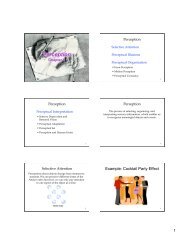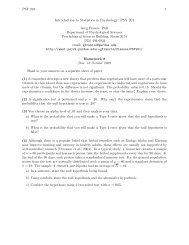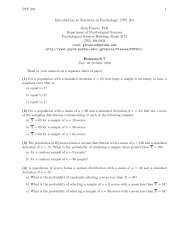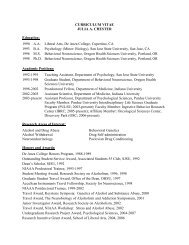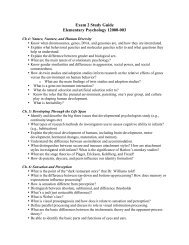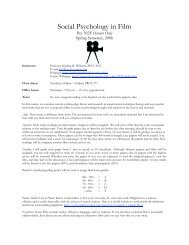Sensation & Perception
Sensation & Perception
Sensation & Perception
Create successful ePaper yourself
Turn your PDF publications into a flip-book with our unique Google optimized e-Paper software.
Sense of Touch<br />
The sense of touch is a mix of four distinct skin senses<br />
—pressure, cold, warmth, and pain.<br />
Bruce Ayers/ Stone/ Getty Images<br />
Touch <strong>Sensation</strong>/<strong>Perception</strong><br />
• The intense tickling<br />
sensation that makes<br />
you laugh<br />
uncontrollably…<br />
– Only happens when<br />
someone else tickles<br />
you<br />
– You cannot tickle<br />
yourself and get this<br />
response (Blakemore, et al.,<br />
2000)<br />
• Why?<br />
Sensory Interaction<br />
When one sense affects another sense, sensory<br />
interaction takes place. So, the taste of strawberry<br />
interacts with its smell and its texture on the tongue to<br />
produce flavor.<br />
25<br />
27<br />
29<br />
Skin Senses<br />
Only pressure has identifiable receptors. All other skin<br />
sensations are variations of pressure, warmth, cold and<br />
pain.<br />
Burning hot<br />
Pressure Vibration Vibration<br />
Taste<br />
Cold, warmth and pain<br />
Traditionally, taste sensations consisted of sweet, salty,<br />
sour, and bitter tastes. Recently, receptors for a fifth<br />
taste have been discovered called “Umami”.<br />
Sweet Sour Salty Bitter Umami<br />
(Fresh<br />
Chicken)<br />
Taste<br />
Scientific American Frontiers:<br />
Tasters and Super-tasters<br />
26<br />
28<br />
30<br />
5



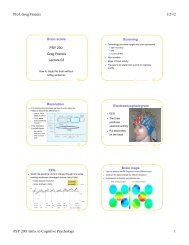



![Exam 4 Study Guide[1]](https://img.yumpu.com/45196739/1/190x245/exam-4-study-guide1.jpg?quality=85)
